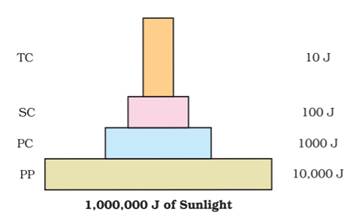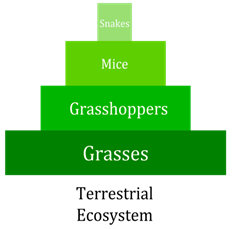What does an Ecological Pyramid indicate ? Explain the three different types of upright Pyramids in nature with the help of an example each.
OR
(a) Indiscriminate human activities such as alien species invasion, fragmentation and habitat loss have accelerated the loss of biodiversity. Justify by taking one example for each.
(b) State the importance of (i) IUCN Red data list and (ii) Hot spots in conservation of biodiversity.
An ecological pyramid is a graphical representation between organism in an ecosystem. It is also known as Energy pyramid Each of the bars that make up pyramid represents a different trophic level, and their order , which is based on who eats whom, represents the flow of energy.
Energy moves up the pyramid , starting with the pyramid producers such as plants and algae at the very bottom, followed by the primary consumer, which feed on these plants , then secondary consumers which feed on the primary consumers.
There are three types of Pyramids:
• Pyramid of Biomass
• Pyramid of Energy
• Pyramid of productivity.
Pyramid of Biomass:
• This has large number of primary producers with smaller trophic level perched on top.
• Ecosystem found on land mostly have pyramid of biomass.
• The biomass of producers is at maximum. The biomass of next trophic level that is primary consumers is less than the producers.. Similarly, the other consumers such as secondary and tertiary consumers are comparatively less than its lower level respectively.
• The top of the pyramid has very less amount of biomass.
Pyramid of Energy:
• It is graphical structure representing the flow of energy through each trophic level of a food chain over a fixed part of the natural environment.
• The energy pyramid represents the amount of energy at each tropic level and loss of energy at each is transferred to another trophic level.
• It is useful in quantifying the energy transfer from one organism to another along the food chain.
• Energy decreases as one moves through the trophic levels from the bottom to the top of the pyramid. Thus, the energy pyramid is always upward.

Pyramid of Number:
• In this the no.of individuals decreases from the lower level to the higher level.
• Usually found in the grassland ecosystem. The grass in the grassland ecosystem occupies the lowest trophic level because of its abundance.
• The no.of producers (1˚producers) is quite less than that of grass.
• Then ,there are the 1˚carnivores e.g.:rat whose number is far less than the grasshoppers.
• The next trophic level is the secondary consumers such as snakes who feed on rats.
• Then , there are the top carnivores such as the Hawks, who eat snakes and whose number is less than the snakes.

OR
(a) Indiscriminate human activities such as alien species invasion, fragmentation and habitat loss have accelerated the loss of biodiversity. Justify by taking one example for each.
(b) State the importance of (i) IUCN Red data list and (ii) Hot spots in conservation of biodiversity.
Solution (a):Fragmentation:
When large habitats are broken u into small fragments due to various human activities, mammals or birds requiring large territories and certain animals with migratory habits are badly affected.
Alien species invasion:
• When alien species are introduced unintentionally or deliberately for some purpose, some of then turn invasive and cause decline /extinction of indigenous species.
• For e.g: The introduction of African catfish( Clarias garpinus) (for aquaculture purpose), poses threat to indigenous catfishes in our rivers.
• The Nile Perch introduced into the lake Victoria in East Africa lead to the extinction of more than 200 species of Cichlid fish in the lake.
• Carrot grass/ Parthenium, Lantana, Water hyacinth/ Eachhornia poses a threat to indigenous species.
Habitat Loss:
The Amazon rain forest is being cut and cleared for cultivating soybeans/ conversion to grasslands for raising cattle.
Solution (b): (i) IUCN- International Union for the Conservation of Nature.
IUCn provides information of extinction of species.
(ii) Biodiversity Hotspot: is a biogeographic region that is both a significant reservoir of biodiversity and is threatened with destruction.
The importance of biodiversity hotspot is was follows;
• Maintaining balance of the ecosystem - recycling and storage of nutrients, combating pollution, and stabilising climate, protecting water resources, forming and protecting soil and maintaining ecobalance.
• Regions with very high levels of species richness, high degree of endemism/ species confined to that region and not found anywhere else are identified which need to be conserve al priority basis.